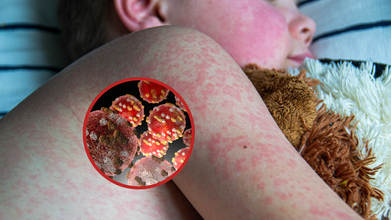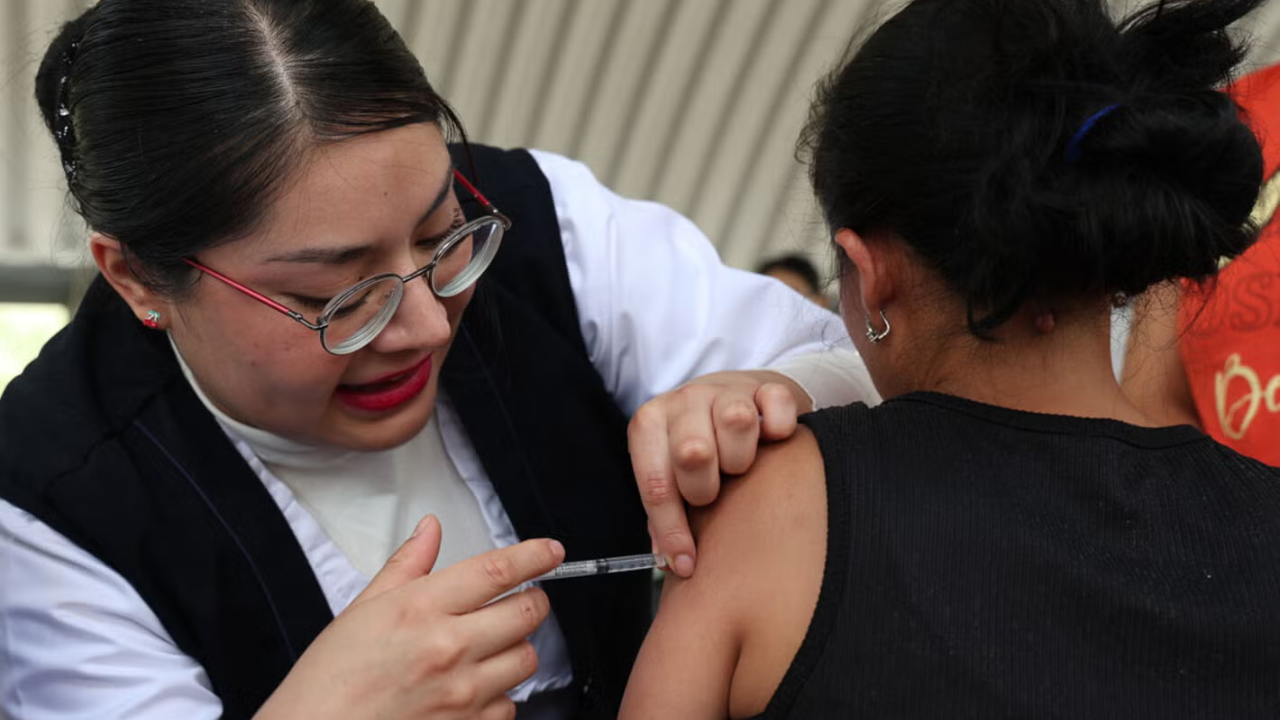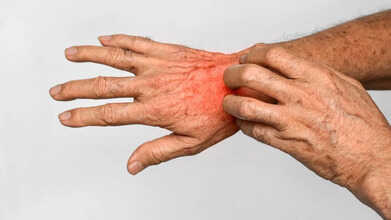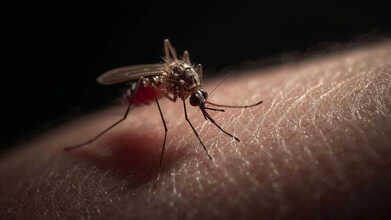- Health Conditions A-Z
- Health & Wellness
- Nutrition
- Fitness
- Health News
- Ayurveda
- Videos
- Medicine A-Z
- Parenting
Measles Cases Surge Worldwide, Korean Health Data Flags Countries At Highest Risk For Travellers

(Credit-Canva)
Health officials around the world are warning travelers about a sharp increase in measles cases. The Korea Disease Control and Prevention Agency (KDCA) is urging everyone to be fully vaccinated before traveling abroad, as many recent cases in Korea have been from travelers returning from other countries.
Globally, measles cases have surged, with the World Health Organization (WHO) reporting around 360,000 cases in 2024. This is largely because of a drop in vaccination rates, which were disrupted during the COVID-19 pandemic
What Should Travellers Be Aware Of?
According to the KDCA, many of these infections came from countries with ongoing measles outbreaks. The number of global measles cases jumped to about 360,000 in 2024, as vaccination efforts were disrupted by the COVID-19 pandemic. The countries linked to the most imported cases are:
- Vietnam
- South Africa
- Uzbekistan
- Thailand
- Italy
- Mongolia
For travelers heading to these regions, the KDCA strongly recommends getting both doses of the measles, mumps, and rubella (MMR) vaccine. This is especially important for adults who may have missed their second dose as children.
Countries That Have The Highest Measles Cases
According to a Pan American Health Organization (PAHO) report released on 15th August, there have been 10,139 confirmed cases and 18 deaths across ten countries, a 34-fold increase compared to the same period in 2024. The countries with the highest number of confirmed cases are:
- Canada (4,548 cases)
- Mexico (3,911 cases)
- United States (1,356 cases)
Cases have also been reported in Bolivia, Argentina, Belize, Brazil, Paraguay, Peru, and Costa Rica. Sadly, there have been deaths in Mexico (14), the U.S. (3), and Canada (1). In Mexico, most of the deaths happened in Indigenous communities, which have been severely affected. Canada also reported the tragic death of a newborn.
The outbreaks are being caused by two different types of the measles virus. One type is spreading quickly among Mennonite communities in eight countries. This shows how fast the virus can move through groups that are not vaccinated. While the outbreaks have mainly been in these communities, more and more cases are now being found in other groups of people as well..

Why Do You Need Measles Vaccine?
Measles is a very contagious illness that can spread easily through the air. While most people think of it as a childhood disease, it can cause serious problems like pneumonia or brain swelling. It's especially dangerous for young children, pregnant women, and people with weak immune systems.
The MMR vaccine is the best way to protect yourself and others. Officials strongly recommend getting both doses, especially if you plan to travel. The KDCA also advises anyone who develops a fever or rash within three weeks of returning to Korea to take immediate precautions: wear a mask, limit contact with others, and tell medical staff about your recent travel before seeking care.
What Steps Have The Countries With Measles Outbreak Taken?
According to PAHO,
- Measles is still spreading in several provinces of Canada, including Alberta and British Columbia.
- In Mexico, the government has launched a mass vaccination campaign in 14 high-priority areas, with a special focus on Indigenous communities in Chihuahua, where most of the country's cases are located.
- In United States, outbreaks have been reported in 41 states, mainly among under-vaccinated populations.
- Most cases of Bolivia are in the Santa Cruz area, affecting both the general population and Mennonite communities.
- Argentina and Belize have not reported any new cases since late June.
PAHO is working with these countries to boost vaccination rates and quickly respond to new outbreaks. While travel restrictions aren't recommended, travelers are advised to ensure they are vaccinated, including young children from 6 to 11 months old, who can get an early dose for protection.
Tini Younger Reveals Losing Baby Girl To Placental Abruption—What Is This Condition?

Credits: Tini Younger Instagram/Canva
Tineke “Tini” Younger shared some devastating news on Wednesday, November 26. The 24-year-old TikTok chef and Next Level Chef alum revealed that one of her twin daughters with husband Antoine Wright Jr. had tragically passed away.
Tini Younger Announces Loss Of Her Baby Girl
Younger said that their daughter Arya, known as Baby A, died just before reaching 36 weeks of pregnancy. In a heartfelt Instagram post, she wrote, "This isn’t the post I ever imagined I would share once the twins arrived. Unfortunately, earlier this week we lost our sweet girl Arya." She explained that despite being so close to full term, she experienced a placental abruption that caused the loss of her baby.
The surviving twin was born safely and is reportedly breathing independently, according to Younger. She has not shared the name of the second daughter.
What Is Placental Abruption?
Placental abruption, medically referred to as abruptio placentae, is an uncommon yet serious complication during pregnancy. The placenta develops inside the uterus and attaches to its wall, providing essential oxygen and nutrients to the growing baby.
Placental abruption happens when the placenta partially or fully detaches from the uterine wall before delivery. This separation can restrict or completely cut off the baby’s supply of oxygen and nutrients while also causing significant bleeding in the mother. According to the Mayo Clinic, the placenta is an organ that forms in the uterus during pregnancy. When placental abruption occurs, the placenta separates from the inner wall of the uterus before birth, which can deprive the baby of vital oxygen and nutrients and lead to heavy maternal bleeding. In some situations, early delivery may be required to protect both mother and child.
Placental abruption often appears suddenly, and if it is not treated promptly, it can pose serious risks to both the mother and the baby.
Symptoms Of Placental Abruption
Placental abruption is most likely to develop in the last trimester of pregnancy, particularly in the final few weeks before delivery. Signs and symptoms may include:
- Vaginal bleeding, though sometimes there may be none
- Abdominal pain
- Back pain
- Uterine tenderness or rigidity
- Uterine contractions, often coming one immediately after another
Abdominal and back pain often start suddenly. The amount of vaginal bleeding can vary widely and does not necessarily reflect how much of the placenta has detached from the uterus. Blood may become trapped inside the uterus, so even in severe cases of placental abruption, there might not be any visible bleeding.
In some instances, placental abruption develops gradually, referred to as chronic abruption. This may cause light, intermittent vaginal bleeding. Babies might grow more slowly than expected, and there could be other complications, such as low amniotic fluid or additional issues affecting fetal development.
What Causes Placental Abruption?
The precise cause of placental abruption is often unknown. Healthcare professionals can, however, identify certain factors that increase the risk. For example, abdominal trauma, including falls or accidents, can raise the chances of experiencing a placental abruption.
If you notice any of these symptoms, it is strongly recommended to seek medical care immediately to ensure both your safety and your baby’s.
Victorian Skin Disease Linked To Intense Itching Surges In The UK: Symptoms To Look For

Credits: Canva
A college in Devon, UK, has issued a public health notice after confirming an outbreak of a disease often tied to the Victorian era. It is not something most people come across today, yet reports show that this old skin condition is appearing more often in modern settings. Although it is usually linked with unclean surroundings, anyone can get it, no matter how carefully they maintain personal or household hygiene.
One woman described her nine-month struggle with the illness. At first she dismissed it as an allergy but soon noticed her son had developed a similar rash and persistent itching. Amanda Rushton from Accrington in Lancashire told The Daily Mail she felt as if her “skin was crawling” once she learnt what she was dealing with.
What Are Victorian Diseases?
In the UK, 'Victorian diseases' refers to illnesses that were widespread during the 19th century and are now returning due to factors such as poverty and limited access to care. These include tuberculosis, cholera, scarlet fever, and scurvy. Many of these conditions are tied to poor sanitation or nutrition.
Tuberculosis was once known as “consumption,” and infections like scabies and measles have also been seen more frequently in recent years, according to the official UK government website.
Victorian Disease Warning In UK
Specialists have raised concerns that more parents choosing to skip routine childhood vaccinations are placing infants and other high-risk groups in danger. The illness circulating at the Devon college is scabies.
“We have been notified of seven confirmed cases of scabies amongst our student community,” read an email from South Devon College in Paignton, reported by DevonLive. “These cases have been diagnosed by a health professional.”
What Is Scabies?
Scabies is a very itchy skin infestation caused by tiny mites known as Sarcoptes scabiei. These mites burrow into the upper layers of the skin to feed and lay eggs. The body reacts to this by producing a rash of small bumps and intense itching, which often becomes worse at night. The condition spreads easily through close and prolonged skin contact and can also pass indirectly through contaminated clothing, bedding, or towels, according to Mayo Clinic.
Scabies tends to spread faster in crowded environments or shared living spaces such as child-care centres or nursing homes. Pets cannot give scabies to humans, as animals carry a different type of mite that causes mange, as noted by the Cleveland Clinic.
Scabies Symptoms To Look Out For
The most common sign of scabies is a fierce, unrelenting itch that worsens at night, along with a rash. You may also notice thin, raised, curved lines called burrows and small bumps or blisters. These usually appear in warm or folded areas of the skin, such as between the fingers and toes. Continuous scratching can break the skin, causing sores or scabs.
Scabies Common Symptoms
Intense itching: This is the leading symptom and often disturbs sleep because of how severe it becomes at night.
Rash: The rash may look like small bumps, pimples, or tiny blisters.
Burrows: These appear as narrow, winding lines created by female mites as they tunnel through the skin to lay eggs.
Sores: Scratching can result in broken skin and crusts.
Common Locations For The Rash
- Between the fingers and toes
- Wrists, elbows, and knees
- The genital region
- Around the breasts or nipples
- The waistline and belly button
- Under the fingernails or watch straps
- In babies and young children, the rash may spread more widely and can show up on the face, head, and neck.
Scabies Cases Rising In The UK
London saw a noticeable increase in scabies toward the end of last year, and similar spikes were reported across northern England, especially in care facilities, nursing homes, and university housing. With cases climbing, doctors are urging people to stay alert to common signs.
Dr Donald Grant, GP and Senior Clinical Advisor at The Independent Pharmacy, explained to Women’s Health last month that although there is no single clear cause for the rise, several factors may be contributing. He told The Independent that this period of the year allows scabies to spread more easily, with children returning to school and students moving into shared accommodation, both of which involve frequent close contact.
He added that scabies is often confused with other skin problems, especially eczema or allergic reactions.
Doctors note that the condition is usually not dangerous, but it must be treated because it passes from person to person so easily. Symptoms may take up to eight weeks to appear after the mites enter the skin. Anyone who suspects they might have scabies should speak to a pharmacist. Every person in the household needs treatment at the same time, even if they do not have visible symptoms.
Brazil Becomes The First Country To Authorise A Single-Dose Dengue Vaccine: All You Need To Know

Credits: Canva
Brazilian authorities on Wednesday approved the world’s first single-dose dengue vaccine, describing it as a “historic” step amid a global surge in cases fueled by rising temperatures. Dengue, which causes severe flu-like symptoms, extreme fatigue, and body aches, hit record global levels in 2024, with scientists linking its rapid spread to climate change. Brazil’s health regulatory body ANVISA cleared the use of Butantan-DV, created by the Butantan Institute in São Paulo, for individuals aged 12 to 59.
Until now, the only dengue vaccine available globally was TAK-003, which requires two doses spaced three months apart, according to the World Health Organization (WHO). Here’s everything currently known about this single-dose vaccine.
Also Read: GRAP 3 Restrictions Revoked In Delhi-NCR: What Residents Can Use Again And What Stays Restricted
Dengue Single Dose Vaccine Approved In Brazil
On Wednesday, November 26, Anvisa approved the world’s first single-dose dengue vaccine. The announcement followed the signing of a term considered the final step in registering the vaccine, produced entirely at a national laboratory, during a press conference, as reported by CNN Brazil. The development of Butantan-DV is the result of collaboration between Brazil’s Ministry of Health, the Butantan Institute, and the Chinese lab Wu Xi.
Butantan-DV: All You Need To Know About The Single Dose Dengue Vaccine
Anvisa stated that the new vaccine uses live attenuated virus technology and is currently approved for people aged 12 to 59—a range that could expand if new studies support it. The Ministry of Health will determine the official vaccination start date and the target age group. The registration request for the vaccine was submitted by the Butantan Institute in January 2025. Anvisa fast-tracked its evaluation, forming a technical panel that included external experts to review the process.
What Is A Live Attenuated Virus?
A live attenuated virus is a weakened form of a virus used in vaccines to trigger a strong and lasting immune response without causing the full-blown disease. These viruses are developed in a lab, often through repeated culturing, so they can replicate in the body but only in a limited way. By closely mimicking a natural infection, they prompt the immune system to respond similarly to how it would during a real infection, according to the U.S. Department of Health and Human Services.
Also Read: CDC To Appoint Vaccine-Skeptic Surgeon Ralph Abraham As Deputy Director
How Effective Is This Single Dose Dengue Vaccine?
CNN Brazil reported that the Ministry of Health found the vaccine to have an overall efficacy of 74.7% against symptomatic dengue for people aged 12 to 59. This means that nearly three out of four people were protected from the disease. Protection was similar for those who had previously had dengue and those who were never exposed to the virus.
In 2024, over 14 million dengue cases were reported globally, marking a record year, according to ScienceDirect and WHO. The death toll reached more than 9,500. While the Americas reported the highest number of cases, dengue continues to affect more than 100 countries worldwide.
Dengue, often called “breakbone fever” because of its intense symptoms, can in severe cases lead to hemorrhagic fever and even death. The disease spreads through infected Aedes mosquitoes, which are now appearing in areas beyond their traditional habitats, resulting in dengue cases in parts of Europe and the United States where it was previously uncommon.
© 2024 Bennett, Coleman & Company Limited

